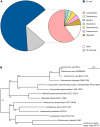Functional divergence in the genus Oenococcus as predicted by genome sequencing of the newly-described species, Oenococcus kitaharae
- PMID: 22235313
- PMCID: PMC3250461
- DOI: 10.1371/journal.pone.0029626
Functional divergence in the genus Oenococcus as predicted by genome sequencing of the newly-described species, Oenococcus kitaharae
Abstract
Oenococcus kitaharae is only the second member of the genus Oenococcus to be identified and is the closest relative of the industrially important wine bacterium Oenococcus oeni. To provide insight into this new species, the genome of the type strain of O. kitaharae, DSM 17330, was sequenced. Comparison of the sequenced genomes of both species show that the genome of O. kitaharae DSM 17330 contains many genes with predicted functions in cellular defence (bacteriocins, antimicrobials, restriction-modification systems and a CRISPR locus) which are lacking in O. oeni. The two genomes also appear to differentially encode several metabolic pathways associated with amino acid biosynthesis and carbohydrate utilization and which have direct phenotypic consequences. This would indicate that the two species have evolved different survival techniques to suit their particular environmental niches. O. oeni has adapted to survive in the harsh, but predictable, environment of wine that provides very few competitive species. However O. kitaharae appears to have adapted to a growth environment in which biological competition provides a significant selective pressure by accumulating biological defence molecules, such as bacteriocins and restriction-modification systems, throughout its genome.
Conflict of interest statement
Figures





Similar articles
-
Consensus pan-genome assembly of the specialised wine bacterium Oenococcus oeni.BMC Genomics. 2016 Apr 27;17:308. doi: 10.1186/s12864-016-2604-7. BMC Genomics. 2016. PMID: 27118061 Free PMC article.
-
Oenococcus oeni: Queen of the cellar, nightmare of geneticists.Microbiology (Reading). 2017 Mar;163(3):297-299. doi: 10.1099/mic.0.000456. Microbiology (Reading). 2017. PMID: 28356170
-
Oenococcus oeni and the genomic era.FEMS Microbiol Rev. 2017 Aug 1;41(Supp_1):S84-S94. doi: 10.1093/femsre/fux034. FEMS Microbiol Rev. 2017. PMID: 28830095 Review.
-
Comparative analysis of the Oenococcus oeni pan genome reveals genetic diversity in industrially-relevant pathways.BMC Genomics. 2012 Aug 3;13:373. doi: 10.1186/1471-2164-13-373. BMC Genomics. 2012. PMID: 22863143 Free PMC article.
-
Genomic variations of Oenococcus oeni strains and the potential to impact on malolactic fermentation and aroma compounds in wine.Appl Microbiol Biotechnol. 2011 Nov;92(3):441-7. doi: 10.1007/s00253-011-3546-2. Epub 2011 Aug 26. Appl Microbiol Biotechnol. 2011. PMID: 21870044 Review.
Cited by
-
Carbohydrate metabolism in Oenococcus oeni: a genomic insight.BMC Genomics. 2016 Dec 1;17(1):984. doi: 10.1186/s12864-016-3338-2. BMC Genomics. 2016. PMID: 27905883 Free PMC article.
-
Phage Encounters Recorded in CRISPR Arrays in the Genus Oenococcus.Viruses. 2022 Dec 20;15(1):15. doi: 10.3390/v15010015. Viruses. 2022. PMID: 36680056 Free PMC article.
-
Expanding the biodiversity of Oenococcus oeni through comparative genomics of apple cider and kombucha strains.BMC Genomics. 2019 May 2;20(1):330. doi: 10.1186/s12864-019-5692-3. BMC Genomics. 2019. PMID: 31046679 Free PMC article.
-
Oenococcus oeni Exopolysaccharide Biosynthesis, a Tool to Improve Malolactic Starter Performance.Front Microbiol. 2018 Jun 12;9:1276. doi: 10.3389/fmicb.2018.01276. eCollection 2018. Front Microbiol. 2018. PMID: 29946314 Free PMC article.
-
Plasmids from Food Lactic Acid Bacteria: Diversity, Similarity, and New Developments.Int J Mol Sci. 2015 Jun 10;16(6):13172-202. doi: 10.3390/ijms160613172. Int J Mol Sci. 2015. PMID: 26068451 Free PMC article. Review.
References
-
- Endo A, Okada S. Oenococcus kitaharae sp. nov., a non-acidophilic and non-malolactic-fermenting oenococcus isolated from a composting distilled shochu residue. Int J Syst Evol Microbiol. 2006;56:2345–2348. - PubMed
-
- Dicks LM, Dellaglio F, Collins MD. Proposal to reclassify Leuconostoc oenos as Oenococcus oeni [corrig.] gen. nov., comb. nov. Int J Syst Bacteriol. 1995;45:395–397. - PubMed
-
- Bartowsky EJ, Borneman AR. Genomic variations of Oenococcus oeni strains and the potential to impact on malolactic fermentation and aroma compounds in wine. Appl Microbiol Biotechnol. 2011;92:441–447. - PubMed
-
- Mills DA, Rawsthorne H, Parker C, Tamir D, Makarova K. Genomic analysis of Oenococcus oeni PSU-1 and its relevance to winemaking. FEMS Microbiol Rev. 2005;29:465–475. - PubMed
Publication types
MeSH terms
Substances
LinkOut - more resources
Full Text Sources
Molecular Biology Databases

